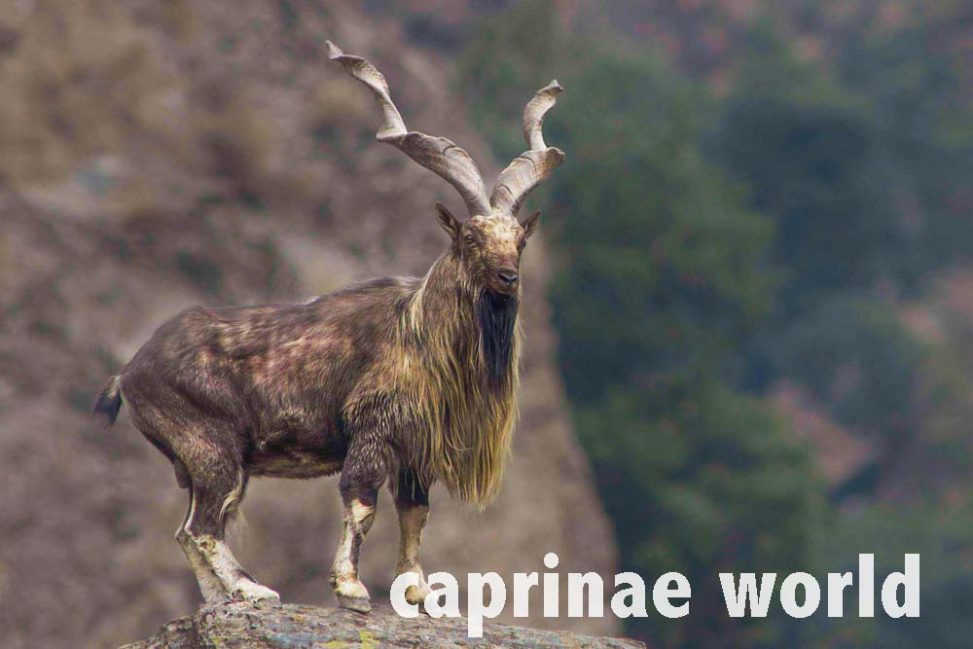According to Valdez (1982) the Astore tpye of the Flare-horned Markhor exhibits the most divergent and spectacular horns of all Markhor.
Names
In many languages the english term „flare-horned“ has not been translated yet. Instead it is still very common to use the old subspecies names.
| English | Astore (Astor) Markhor [2], Screw-horned Goat [1] | Kashmir Markhor [1, 2] |
| in India | Kazinag, Pir Panjal Markhor [2] | |
| German | Fackelhorn-Markhor* | |
| Flachhörniger Markhor [7], Astore-Schraubenziege [2], Astor-Schraubenziege [1] | Kaschmir-Schraubenziege [2], Kaschmir Schraubenziege [1] | |
| French | Markhor d’Astore [2], Markhor d’Astor [1] | Markhor de Cashmire [1, 2] |
| Spanish | Markor de Astore [1], Marjor de Astore [2] | Marjor de Cashmir [2], Markor de Cachemira [1] |
| Balti | Rocho-ridakh [2] | ditto |
| Bal(u/o)chi | Pachin, Sara (male), Buzkuhi (female) [2] | ditto |
| Brahui | Rezkuh, Matt (male), Hit, Harat (female) [2] | ditto |
| Ladakhi | Rache, Rapoche (male), Rawache (female) [2] | ditto |
| Punjabi, Pashto, Kashmiri | Markhor [2] | ditto |
| Shina & Burushakshi | Halden, Haldin (male), Giri, Giri Halden (female) [2] | ditto |
*German: Matschei (2012) has introduced the name “Flachhörniger Markhor”. In our view this name is a legitimate subject for debate: Even though the horn alignment in the Flare-horned Markhor shows some horizontal spreading, the general orientation of the horn axis remains vertical. Therefore “flachhörnig” (flat-horned) seems not appropriate.
The idea behind the term “Flare-horned Markhor” was probably to describe that the two horns emerge at a common basis and then gradually become wider.
„Flare“ as a noun in German has various meanings like „Leuchtfackel“, „Leuchtsignal“ or „Aufbrausen“, but can’t be used in combination with the horns. As an adjective „lodernd“, „aufflackernd“ or „aufweitend“ it would describe the horn shape to a certain extent. But again, to use it in combination with „Horn“ seems inappropriate. Imagine „Loderhorn-“, „Flackerhorn-“ or „Aufweithorn-Markhor“.
Another more common German name in biology to describe organisms with a shaft and multiple arms is „Kandelaber“ (candelabra), e.g. „Kandelaber-Königskerze“, „Kandelaber-Wolfsmilch“ or „Kandelaber-Primeln“. Commonly the term is used for a candlestand. However the name seems a bit oldfashioned and is not used in spoken language.
With that said, we recommend „Fackelhorn-Markhor“, which would be a combination of an abbreviation of „Leuchtfackel“ and „Horn“. This term is visually convertible, it is close to the english equivalent, it is not too intricate and gives the namebearer some sort of regality – which the Markhor in general deserves in the view of probably large parts of the population.
Other scientific names and synonyms
(Aegoceros) Capra falconeri falconeri, Wagner 1839; Capra falconeri typica, Lydekker 1908
Distribution
by country/state: Afghanistan, India, Pakistan
Afghanistan: historically occurred in the eastern portion of the country, in the high mountainous, monsoon forests of Laghman (headwaters of Alingar and Alishang Rivers); Kunar and Nuristan (Habibi 1977, Petocz 1972, Petocz and Larsson 1977) and is still extant at least in south central Nuristan (WCS 2008, Stevens et al. 2011). [6]
India: restricted to part of the Pir Panjal Range in southwestern Jammu and Kashmir (Ranjitsinh et al. 2005, Bhatnagar et al. 2007, Bhatnagar et al. 2009). Populations are scattered throughout this range, starting from just east of the Banihal pass (50 km from the Chenab River) on the Jammu-Srinagar Highway westward to the disputed border with Pakistan. Bhatnagar et al. 2009 observed Markhor only in Kajinag and Hirpura, and confirmed evidence of their occurrence in Boniyar and Poonch. In the areas of Shamsabari and Banihal Pass the taxon is likely extinct. [6]
Pakistan: The vernacular name Astore Markhor goes back to the small mountain hamlet of Astore in the Astore Valley, about 60 km southeast of Gilgit, on the eastern side of the Nanga Parbat. [2]
A detailed study on the past and present distribution of “Kashmir” Markhor by Arshad (2011) showed that the area of occupancy and the number of locations have declined greatly (approx. 70%) during the 20th century. However, historic ranges larger than present ranges are partly a result of too much generalization in the older distribution maps, which include large sections of unsuitable habitat. It is not clear to what extent exchange takes place between the often small groups of Markhor inhabiting different watersheds. [6]
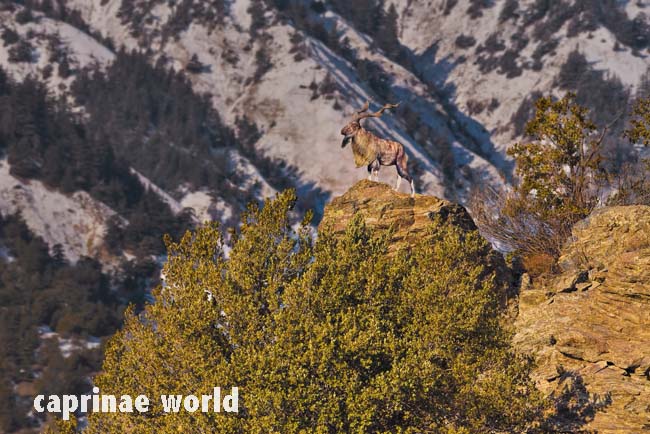
Flare-horned Markhor are mainly confined to the Indus and its tributaries, as well as to the valleys of the Kunar (Chitral) River and its tributaries. According to Schaller and Khan (1975), along the Indus River, Markhor inhabited both banks from Jalkot (District Kohistan) upstream to near the Tungas village (District Baltistan), with Gakuch being its western limit on the Gilgit River, Chalt and (Haraspo) Sikandarabad on the Hunza River, and the Parishing Valley on the Astor River. Currently, Markhor are known from various locations in the Diamer, Astor, Gilgit and Baltistan Districts. Markhor are found along the Nagar Hunza River from Sikandarabad downstream, in Naltar Valley, along the Gilgit River downstream from Singul and along the Indus River downstream from Basho to the provincial border with Khyber-Pakhtunkhwa (WCS, Mayoor Khan pers. comm. 2014). Markhor are known to be present in the Juglot Ghooro, Rahimabad and Haramosh valleys in Central Karakoram National Park (Athar A. Khan and Syed Yasir Abbas, Ecologist, Central Karakoram National Park, pers. comm. 2014). The population in Haramosh was considered extinct by Arshad (2011), but since winter 2011 Markhor have been observed there (Athar A. Khan and Syed Yasir Abbas, pers. comm. 2014), possibly indicating natural recolonization. The distribution range in Gilgit-Baltistan has been updated based on information from various sources (WCS, Mayoor Khan pers. comm. 2014). In Khyber-Pakhtunkhwa, Flare-horned Markhor were found around Chitral and the border areas with Afghanistan where it inhabited valleys along the Kunar River (Chitral District), from Arandu on the west bank and Drosh on the east bank, up to Shoghor along the Lutkho River, and as far as Barenis along the Mastuj River (Schaller and Khan 1975). The distribution range in Chitral has been updated based on Arshad (2011), and includes side valleys of the Indus River upstream from Dubair, the Shishi River Valley as well as the Chitral River Valley and its tributaries upstream from Chitral up to Kaghozi Gol (Mastuj River Valley) and Shogore (Lutkho River Valley). [6]
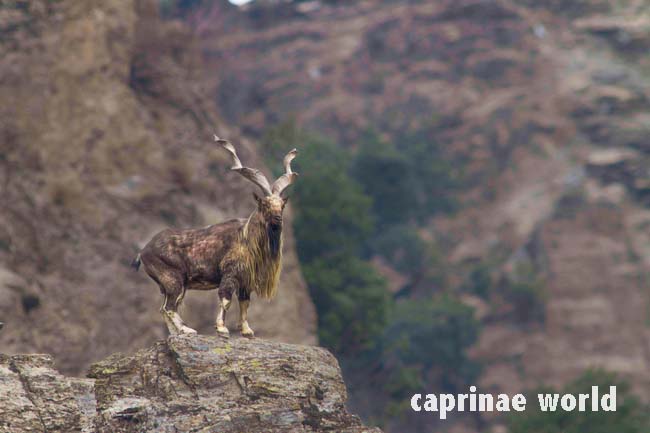
Description
Table 1: Some measurements of Flare-horned Markhors – extracted from Damm and Franco (2014)
| Astore | Kashmir | ||
| length / head-body | one adult Astore male: 186 cm (Ward, 1924) | ||
| one male from Baltistan: 185 cm (Stockley, 1926) | |||
| one female from Baltistan: 150 cm (Stockley, 1926) | |||
| weight (kg) | adult males: 100-109 kg (Ward, 1924) | mature, adult males: around 90 kg, rarely exceeding 110 kg | |
| captive 4,5 years, adult male, near Gilgit: 80 kg (Roberts, 1977) | |||
| shoulder height (cm) | one adult Astore male: 99-101,5 cm (Ward, 1924) | 96,5 (Rowland Ward, 1907) | |
| one male from Baltistan: 104 cm (Stockley, 1926) | |||
| one female from Baltistan: 72 cm (Stockley, 1926) |
diploid chromosome number: 2n=58 [2]
Colouration / pelage
The pelage of Astore and Kashmir Markhor is similar: reddish-gray with more yellowish-buff tones in the smooth and short summer coat, growing longer, thicker and greyer in winter. [2] Kashmir Markhor may show a faint light dorsal stripe. [2]
Horns
According to Valdez (1982) the Astore Markhor exhibits the most divergent and spectacular horns of all Markhor. In the Astore type horns flare widely just above the base and usually have no more than 1,5 open spiral twists (Schaller, 1977), with the first turn usually very expansive. The horns of the Kashmir phenotype have a slight to moderate flare and usually a less open spiral than the Astore type, with two to three twists. [2]
Table 2: Horn measurements (cm) in Astore and Kashmir Markhor – extracted from Damm and Franco (2014)
| Astore | Kashmir | |
| longest (Kafr Nullah, 1927) | 154,3 | 165,1 |
| longest SCI, 1984 | 158,8 | |
| second longest SCI, 2006 | 123,2 | |
| median length, 1891-2008, (n=64) | 128,3 | 126,7 |
| median length, 1898-1933 | 133,0 | |
| median length SCI, 1965-2008, (n=29) | 99,4 | |
| widest spread, 1891 | 132,1 | 120,7 |
| smallest spread | 44,5 | 62,2 |
| mean spread | 92,4 | 88,4 (n=36) |
| median circumference | 27,9 | 27,9 |
The horn length differences over time in Astor and Kashmir Markhors point towards a significant reduction in trophy quality, probably caused by over-exploitation in the second half of the 19th and first half of the 20th century. [2]
Notably the quality of Astore Markhor trophies declined substantially. Most of the 52 Astore Markhor heads evaluated had been collected before 1925. Only 11 heads were registered after 1950. The mean horn length difference between historic heads prior to 1933 (n=40) and those taken later than 1950 (n=11) stands at 31,7 cm. [2]
Unfortunately, only about half the trophies harvested under the sustainable community hunting schemes in Pakistan have been registered in either SCI or RW, although the importance of meticulously measuring and recording all Markhor trophies cannot be overemphasized. Transparent data collection and proper control systems are urgently needed. [2]
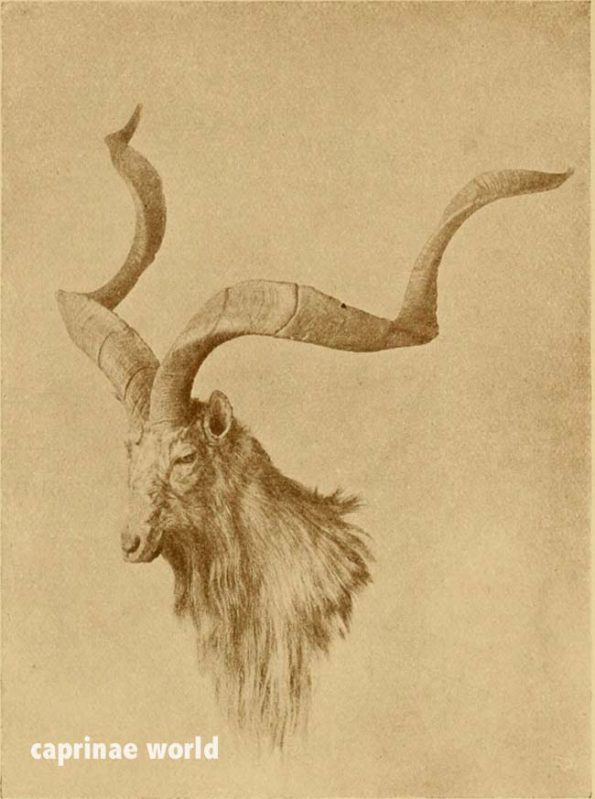
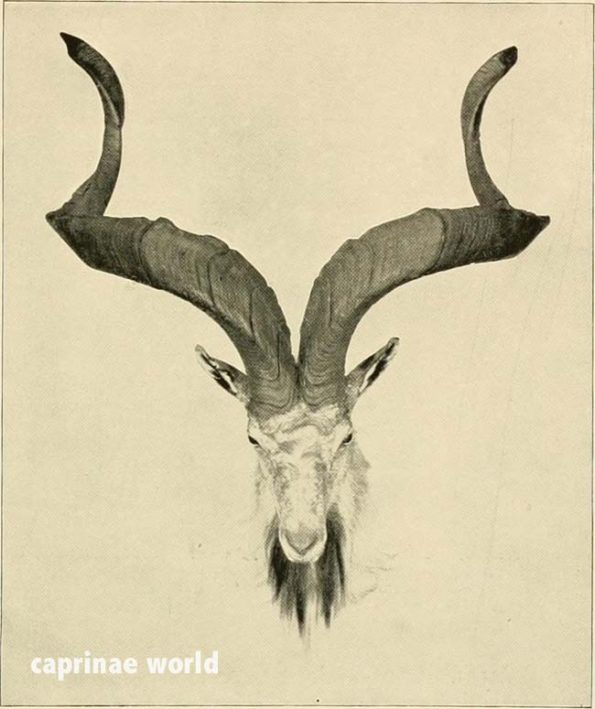
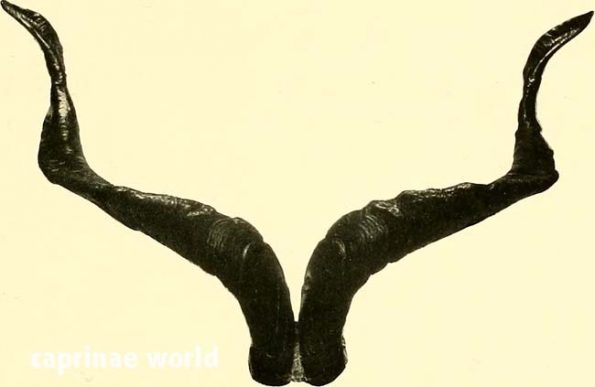
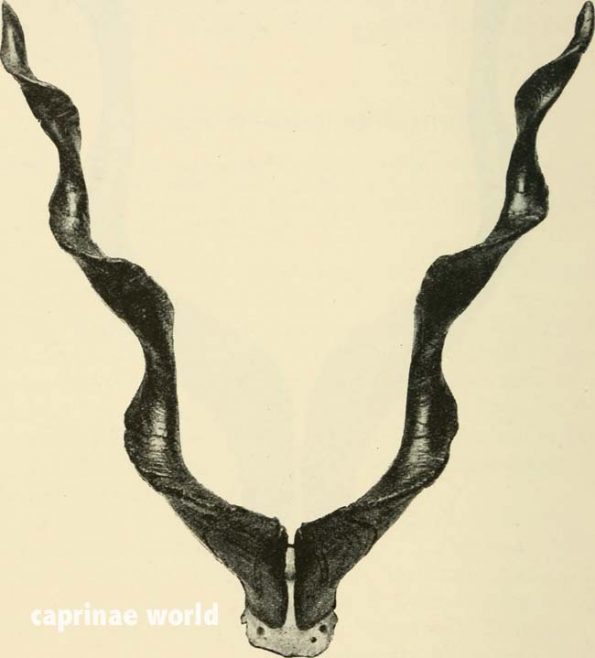
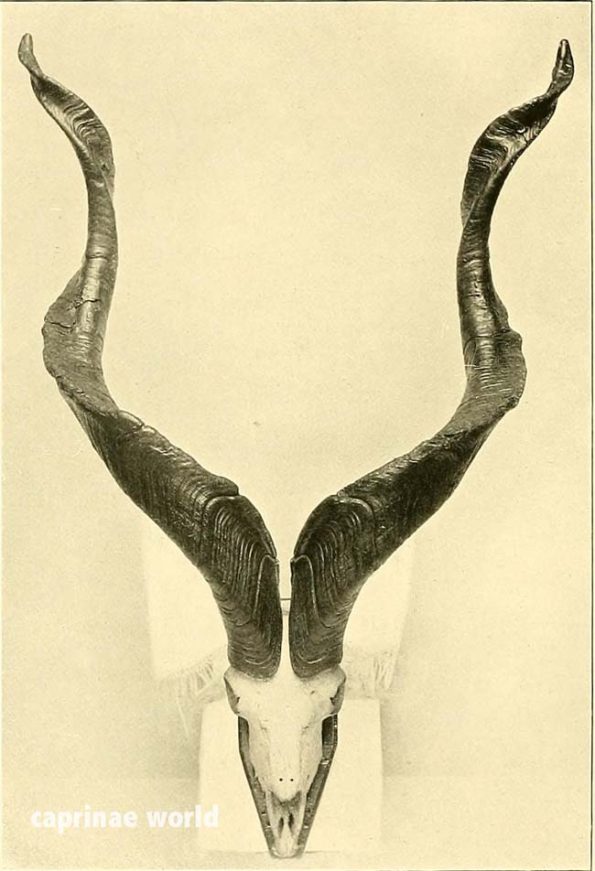
Differences between Astor and Kashmir Markhor – Are there any at all? Damm and Franco (2014) write: „One is hard pressed to find any significant difference in the pelage. The only difference, apart from the notable one of horn flare and twist in typical specimens of both races, is that most of the Astore Markhor, but not all, do not appear to have a black stripe on the otherwise whitish forelegs.“ For the Kashmir type they note „some darker areas on … top parts of the forelegs“ in the winter coat. But two section further down they mention „the legs below the knees are white“.
Apart from the horn flare, the differences in the horns of the Astore and Kashmir types can probably be considered insignificant from a taxonomic point of view and justify Schaller’s suggestion to unite both types und flare-horned Markhor. [2]
Status
In Afghanistan, during a survey in April 1972, 37 Markhor were counted in the upper Alingar Valley, and numerous signs of presence and reports by local hunters were documented there and in the upper Alishang Valley, suggesting a viable population (Petocz 1972). In south central Nuristan Petocz and Larsson (1977) recorded 350 Markhor, but considered this number a small proportion of the local population. The observed sex-age structure indicated high reproduction and possibly a fairly stable population size or moderate decline despite hunting pressure. In contrast, in eastern Nuristan Petocz et al. (1977) found a dramatic decline caused by hunting. Camera surveys, hunter interviews, and participatory distribution mapping conducted by the Wildlife Conservation Society (WCS) in south central Nuristan during 2006-2007 and 2008 (WCS 2008, Stevens et al. 2011) suggested that the species was still present in the area surveyed by Petocz and Larsson (1977) and that the occupied range area was still largely the same. Although a 370 km transect survey by the WCS team recorded only three individuals, information obtained from local hunters and the importance of the species as main object of hunting indicated a population at least in the range of up to a few hundred animals. [6]
In India, a survey of the species October 2004 to April 2005 in the Hirpura and Kajinag areas of the Pir Panjal Mountains in Jammu and Kashmir, recorded 35 Markhor groups, comprising 155 individuals (Ranjitsinh et al. 2005). This count, as well as interviews with key local informants, indicated that 350–375 Markhor may have existed in the surveyed area of Jammu and Kashmir. This is slightly higher than earlier numbers of 200–300 (Schaller 1977, Fox and Johnsingh 1997), probably because earlier reports were incomplete guesses based on information from only parts of the Kashmir Valley. The taxon’s range had contracted from about 300 km² in the late 1940s to about 120 km² in 2004–2005. (Bhatnagar et al. 2009) [6]
For Pakistan, population numbers are available for various time periods and for different locations. Areas were surveyed during different seasons. The numbers we present are based on differing methods (counts, estimates, guesses), and names, locations and borders of specific sites are not always clearly defined. Most recent numbers are available for 2011 and 2012, suggesting a total number of about 4.500 Flare-horned Markhor. More than 1.500 occurred in Gilgit-Baltistan (WCS 2012), 2,959 in Khyber-Pakhtunkhwa (Iftikhar Uz Zaman pers. comm. 2014); and Arshad (2011) believed that in Azad Jammu and Kashmir approximately 50 Markhor existed. If these figures are correct, they indicate a substantial increase from the previous Red List assessment (Valdez 2008), when less than 2.500 to 3.000 Flare-horned Markhor were assumed to survive in Pakistan. Approximately 21 years before the current assessment (or about three generations), there were thought to be in total about 2.075-2.575 Flare-horned Markhor, including 1.075 in Khyber-Pakhtunkhwa (NWFP 1992) and 1.000-1.500 in Gilgit-Baltistan (NA Forest Department unpubl. information 1993, reported in Valdez 2008). Thus numbers in Gilgit-Baltistan may have remained stable or increased, while the population in Khyber-Pakhtunkhwa appears to have increased substantially. [6]
Schaller and Khan (1975) assumed a total of at least 5.250 Flare-horned Markhor living in Pakistan and in India. Petocz (1972) and Petocz and Larsson (1977) counted 387 animals in Afghanistan. The total population number of the subspecies at this time was thus about 5.650 Markhor (about 3.380 mature individuals). Available data suggest that during the period 1985-1993, the total number for the subspecies might have been around 2.950 (1,770 mature individuals). Arshad (2011) assessed the total population number for “Kashmir” Markhor alone at 1.800–2.000 individuals. An educated guess, combining data from different areas, suggests that as of 2012, the total population of C. f. falconeri was close to 5.000 (i.e., about 3.000 mature individuals). Hence the total population of this subspecies apparently decreased from the early 1970s to the early 1990s, but since then it appears to have recovered. [6]
Data for specific locations in Pakistan show varying trends of population numbers:
- In 1970, the Chitral Gol, a valley of 77.5 km² in the Chitral District of Khyber-Pakhtunkhwa Province (formerly NWFP), and at that time the private hunting reserve of the Mehtar of Chitral, was estimated to harbour 100 to 125 animals (Schaller and Mirza 1971). In 1984, this area was declared a National Park, and by 1985-86, it contained 160 (recorded) to 300 (estimated) animals. In addition, the proportion of males > 4.5 years in the population increased during the same period (Hess 1986). Within this time span, Aleem (1979) recorded a maximum of 520 animals in Chitral Gol in 1979. The increase was attributed to better protection from poaching and to other improvement efforts in the Park (Malik 1985). However, according to Ahmad (unpubl. data, quoted in Valdez 2008), the population in Chitral Gol National Park was reduced to 195 Markhor in 1987. Estimates by Arshad (2011) showed an increase to 373 in 2003 and 590 in 2005/2006. Ali (2008) confirmed the positive trend leading to 612 Markhor recorded in 2006 with a computed annual growth rate of 7.7%. I. Uz Zaman (pers. comm. 2014) reported an increase of the estimated population in Chitral Gol National Park Wildlife Division (including Chitral Gol National Park and its buffer zone, Arshad pers. inf. 2014) from 1.146 in 2009 to 1.364 Markhor in 2012, a greater rate of growth than that suggested by a projection of the data presented by Ali (2008). The precision of these estimates cannot be assessed, as some earlier counts may have been biased low, and the area covered during different surveys might have changed and be thus not directly comparable. Nevertheless, these estimates suggest a substantial increase in the Chitral Gol National Park and adjacent areas.
- For the Tushi Game Reserve (GR) in the Chitral District, Schaller and Khan (1975) estimated 125 animals, similar to the estimate in 1985-86 (anonymous 1986, Hess in press, quoted in Valdez 2008). In the Tushi Shasha Conservancy, Ali (2008) observed 137 Markhor in 1990 and 545 in 2006, from which he calculated an annual population growth of 7.9%. For the entire Chitral Wildlife Division (without Chitral Gol National Park Wildlife Division) I. Uz Zaman (pers. comm. 2014) reported an increase of the estimated population from 1.049 in 2009 to 1.456 Markhor in 2012.
- The NWFP Forest Department (NWFP 1992) estimated 221 Markhor in Kohistan and 58 in Swat of Khyber-Pakhtunkhwa Province. According to I. Uz Zaman (pers. comm. 2014) numbers recorded in Kohistan from 2009 to 2012 varied between 128 and 233, whereas recorded numbers in Swat decreased from 110 in 2010 to 11 in 2012.
- The population of Markhor in the Kargah Wildlife Sanctuary (Gilgit District of Gilgit-Baltistan Province) was estimated by Roberts (1969) as not less than 500 to 600 animals; by Schaller and Khan (1975) as 50; by Rasool (no date, probably 1976, quoted in Valdez 2008) as 109; by Hess (1986) as 50 to 75; and by Rasool (unpubl. data, quoted in Valdez 2008) in 1991 as 40-50. In 2012 this population had reportedly recovered to 300 animals (WCS 2012). [6]
Threats
Within Afghanistan, Markhor have traditionally been hunted in Nuristan and Laghman, and this may have intensified during the Afghan wars since 1979. According to surveys by WCS in Nuristan during 2006-2007 and 2008 (WCS 2008), Markhor continue to be the most important game for local hunters (despite a nominal nationwide ban on hunting). Petocz and Larsson (1977) wrote that rangelands and forests were likely capable of supporting a higher Markhor population than that observed. They assumed that impact of livestock grazing on habitat conditions was limited because the number of domestic animals was restricted by the area’s capacity to produce and store winter fodder, as heavy snowfall prevents winter grazing. Recent numbers of livestock are unknown for Nuristan, but recent increases associated with an expanding human population may create competition for forage (WCS 2008). According to a study using recent satellite imagery (Delattre and Rahmani 2007) no large-scale deforestation of the coniferous forests was observed in Markhor habitat in Afghanistan. However, the extent of deforestation for the last five years in a region affected by war and largely out of state control is unknown. [6]
In India, all Markhor populations are small (usually < 50) and fragmented. The largest population, in Kajinag, may have potential for long-term survival if immediate conservation measures can be implemented. Key threats to the Markhor’s range are insurgency-related effects, intensified local resource use, poaching, and large-scale development. Poaching by professional hunters may have been the primary cause of decimation of Markhor in the past, but communal hunting during winter was practised until recently. Armed conflicts may have increased poaching by both the military and militants, while poaching by local people may have declined due to confiscation of arms and restriction on human movements. Other pressures come from habitat encroachment by camps of Gujjars and the armed forces, excessive livestock grazing by local and nomadic Bakkarwal herders in parts of the range, and collection of timber and other forest products. Large scale development includes the proposed Mughal road connecting the state capital Srinagar with Rajouri, which passes through the Hirpura Wildlife Sanctuary, and limestone and gypsum mining around Limbar and Lacchipora Wildlife Sanctuaries. The Indian Government has fenced the entire Line of Control with multi-layered barbed wire. This may have caused further fragmentation of populations of Markhor (Bhatnagar et al. 2009). [6]
In Pakistan, control of poaching in Chitral Gol National Park and in several community-based conservancies has been successful. There, the population is stable or increasing. However, many subpopulations of Flare-horned Markhor are still small (< 100) and the level of connectivity between them is unknown. The major threat outside established conservancies is poaching. [6]
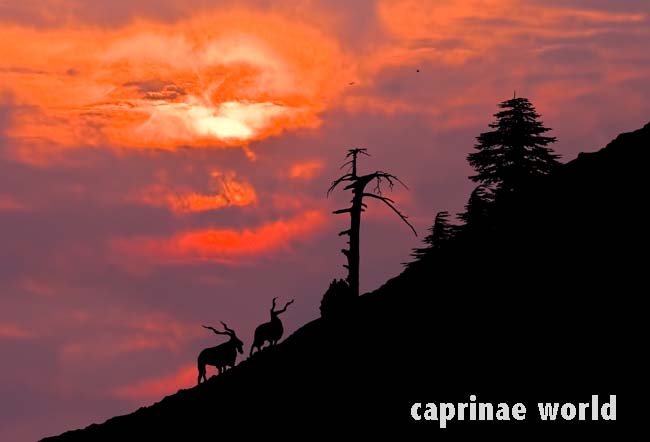
Conservation / hunting
The WWF Pakistan Gilgit-Baltistan Conservation Project and the Mountain Areas Conservancy Project (MACP) have successfully implemented Markhor conservation programs in Gilgit-Baltistan. Through cooperative efforts between stakeholders from provincial authorities and mountain village communities, wildlife populations in general (including Snow Leopard) and Markhor in particular, have increased, unregulated hunting and poaching – at least of mountain ungulates – has been halted, and socio-economic conditions for the mountain communities in the area have been enhanced through various development activities. Ultimately, the increase in Markhor numbers allow carefully designed revenue-generating trophy-hunting programs. This alone already justifies the division of the Flare-horned Markhor into two phenotype categories, since this subdivision, although admittedly not of taxonomic consequence, substantially increases the economic value for both Markhor phenotypes. [2]
For the 2010/11 hunting season a total of four Astore Markhor permits were offered for public auction and sold at prices between US Dollar 45.000 and 55.000. Hunting opportunities under these permits were distributed to four different community-controlled hunting areas (CCHA), which are all situated around Rakaposhi, the famous mountain of the Hunza people:
- Skoyo-Karabathang-Basingo (SKB) in Skardu Conservancy
- Hushey CCHA and the Shahi Khyber Imamabad Welfare Organisation (SKIWO)
- Bunji Community Conservation Area (BCCA), Diamir District
- Dashkin-Mushkin-Turbiling (DMT)
Trophy hunting of Kashmir Markhor is open or under planning process in four Community conservancy areas (CMCAs):
- Tooshi-Shasha Conservancy (Chitral) – over 600 Markhor; receives two of four KPWD Markhor permits (Khyber-Pakhtunkhwa Wildlife Department)
- Gehrait-Goleen Conservancy (Chitral) – receives one KPWD Markhor permit
- Mankial Valley Conservancy (Swat) – presently has no KPWD Markhor quota
- Kaigah Nullah Conservandcy (Kohistan) – 71 Markhor (1999); receives one KPWD Markhor permit
Markhor licenses are offered yearly on puplic auctions and are usually awarded to the highest bidder. The funds from trophy hunts are managed through a cooperative agreement between the provincial and federal government and the local village conservation committee that oversees allocation on the funds; 80 per cent of the permit fees will be deposited in a Village Conservation Fund as the communities‘ share. [2]
Literature cited
[1] Castelló, José R., 2016: Bovids of the World – Antelopes, Gazelles, Cattle, Goats, Sheep, and Relatives. Princeton University Press
[2] Damm, Gerhard R. and Franco, Nicolás, 2014: The CIC Caprinae Atlas of the World – CIC International Council for Game and Wildlife Conservation, Budakeszi, Hungary in cooperation with Rowland Ward Publications RSA (Pty) Ltd., Johannesburg, South Africa
[4] Groves, Colin and Grubb, Peter, 2011: Ungulate Taxonomy. The John Hopkins University Press
[5] Grzimek, Bernhard (Hrsg.), 1988: Grzimeks Enzyklopädie, Säugetiere, Band 5. Kindler Verlag, München
[6] Michel, S. & Rosen Michel, T. 2015. Capra falconeri (errata version published in 2016). The IUCN Red List of Threatened Species 2015: e.T3787A97218336. https://dx.doi.org/10.2305/IUCN.UK.2015-4.RLTS.T3787A82028427.en. Downloaded on 06 May 2020.
[7] Matschei, Christian, 2012: Böcke, Takine & Moschusochsen. Filander Verlag
[10] Schaller, George B., 1977: Mountain Monarchs – wild sheep and goats of the Himalaya. The University of Chicago Press
[16] Wilson, D. E. and Mittermeier, R. A. [eds], 2011: Handbook of the mammals of the world. Vol. 2. Hoofed mammals. Lynx Edicions, Barcelona.

